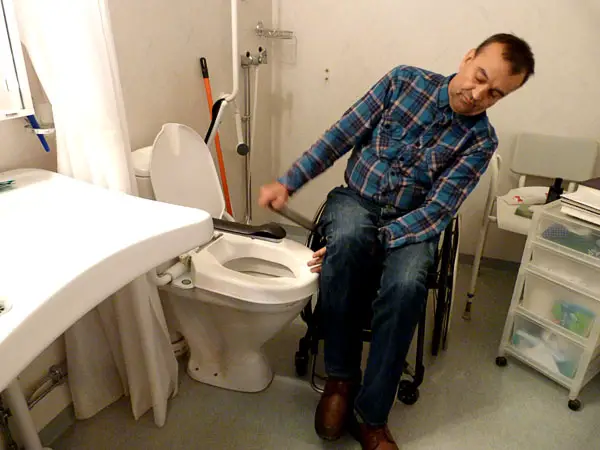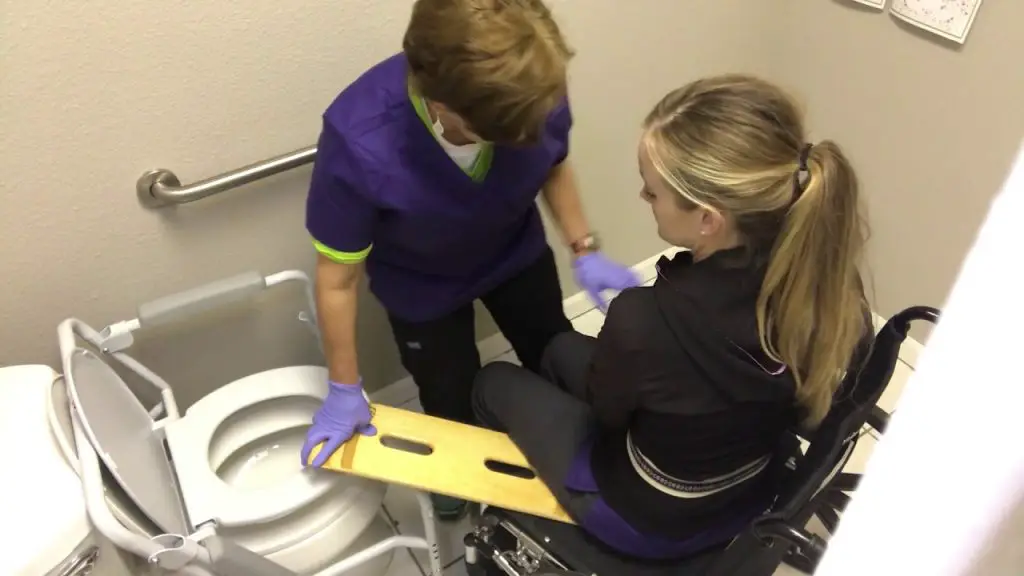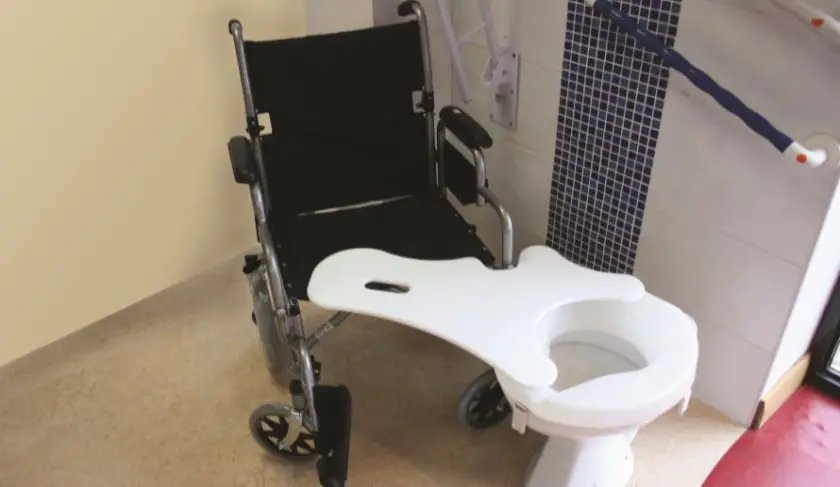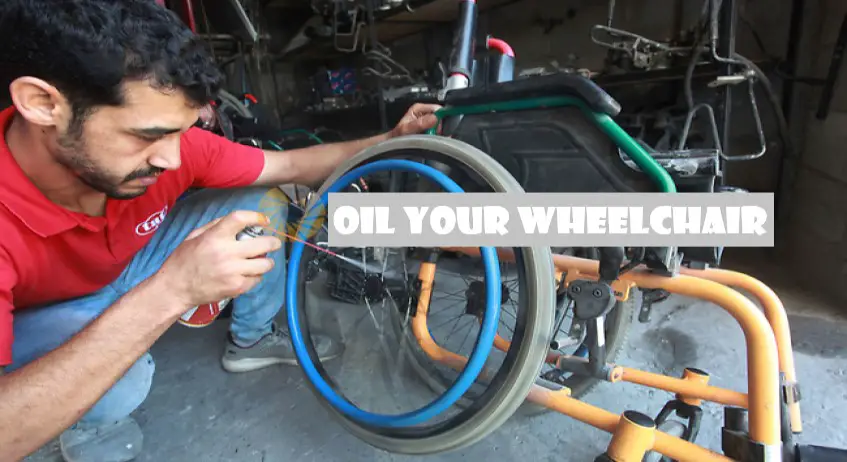Going to the restroom is one of the most strenuous chores, which can result in frustration for the disabled individual.
However, the disabled who still have full or intermediate use of the limbs can reduce this stress with a transfer board – which might seem complex to use initially.
Using a transfer board requires a lot of practice, time, and patience, but once you get comfortable with the techniques, it will become an excellent solution for your restroom independence.
You might be wondering what a transfer board is. Below you will find its meaning and its benefits.
Table of Contents
- A Transfer Board and its Benefits
- Using the Transfer Board from Wheelchair to Toilet Alone
- Using the Transfer Board from Wheelchair to Toilet with a Caregiver
- Important Tips for Using the Transfer Board
A Transfer Board and its Benefits
A transfer board, a.k.a ‘slide board,’ is a flat board that allows a disabled individual to move between surfaces without the help of the legs or a caregiver (of course, only after adequate practice). It can either be wooden or plastic.
It helps you get from one surface to the other, especially from the wheelchair to the bed, sofa or, toilet.
As small as it may seem, it bears the weight of the disabled individual when the transfer is going on.
It helps any injured, disabled individual facing a long traumatic recovery; it might even be the only transfer method from surfaces onto the wheelchair.
It helps relieve the pain in your shoulders and chest muscles due to the pressure of lifting yourself or being lifted by others.
Related: How to Easily Change a Diaper in a Wheelchair (Complete Guide)
Using the Transfer Board from Wheelchair to Toilet Alone

Wheel yourself to the bathroom and set your wheelchair close to the toilet seat, forming an angle of 30 degrees or preferably 45. Lock the brakes of your wheelchair.
Take off the footrests if possible. Otherwise, turn them to the other side, so they are not in your way.
Remove the armrest, close to the wheelchair, of your toilet seat if built with detachable armrests. It will give you enough space to fix the transfer board between the wheelchair and the toilet seat without any hindrance.
Get the transfer board ready (you can paste a short length of Dycem® on the toilet seat if you have one) and position yourself by leaning away from the toilet seat, then fix the transfer board underneath your hip.
When fixing, place the transfer board edge downward (towards the toilet seat) with the tapered edge facing up to not tweak your skin.
Begin your slides by making small and steady movements across the board until you settle onto the toilet seat. Keep your transfer board by the closet so that it is within reach.
Once settled on the toilet seat, lean side to side to take off your pants or clothing.
When done, get yourself cleaned up and pull your pants back up. It will not be as easy as when you pulled them down because your leaning sideways will be extra, and you might tend to fall. Ask for help if available and when necessary.
Fix the transfer board beneath your hips and make the edge of the transfer board downward (towards the wheelchair) with the tapered edge facing up. Then, just as before, begin your slides slowly across the board till you are back in the wheelchair safely.
Remove the transfer board, fix your footrests back and wheel yourself out of the toilet.
Related: How to Wash Someone’s Hair in a Wheelchair
Using the Transfer Board from Wheelchair to Toilet with a Caregiver

Wear your gloves and wheel the disabled to the bathroom. Take off the footrests and move the wheelchair as close as possible to the toilet seat. Lock the brakes of the wheelchair.
Put on a gait belt for the disabled, if it is available. The gait belt helps with control and stability when transferring, especially if the disabled suffer from a loss of balance and unsteadiness.
Push up the wheelchair armrest, then remove the one close to the toilet seat. Next, get the transfer board ready and control the disabled with your knees by locking the disabled knees between yours.
Fix the transfer board beneath the hip of the disabled and make the tapered edge face the toilet seat to form a descending hill. Move the disabled slowly until you can slide them across the board over to the toilet seat successfully.
Lean the disabled sideways and forward to get the pants off, then steady the disabled back.
Once the disabled complete their toilet activities, clean up and repeat the same process. Remember, this time, to make the tapered edge of the board face the wheelchair, forming a downward slide towards the wheelchair seat.
Related: Complete Guide On Choosing Disabled Clothing for Wheelchair Users
Important Tips for Using the Transfer Board
Start with a bedside commode when practicing using the transfer board to get your body accustomed to the toilet seat.
A short transfer board is more suitable than a long transfer board unless the long one is necessary due to an ample amount of space between your wheelchair and the toilet seat.
Raise your toilet seat to the same level as your wheelchair seat. Most importantly, your toilet seat should be flat-shaped and not concave like the usual ones. It will help stabilize the transfer board and prevent it from sliding, which can cause you to lose your balance or fall off.
Don’t use any other object or equipment in place of a transfer board; hence always try to keep it nearby for your next use.
Always ensure there is enough room for your wheelchair and your toilet seat in your bathroom. Preferably use a wheelchair with a swing or detachable armrest. Otherwise, use what you have.
As time goes by with the practice, you might get comfortable using the transfer board without a caregiver, but whenever you feel you might not be up to the task, don’t hesitate to ask for help.
Ensure your clothing is easy to remove (especially when you are on the toilet seat) and at the same time covers your lower hips so that they don’t stick to the surface of the transfer board and restrict your movement.
A Dycem®, which is a double-sided sticky silicone, will help with gripping the transfer board on the toilet seat, as the board has a smooth wooden surface, and your toilet seat has a smooth plastic surface. Hence, both can tend to slip away from each other.




